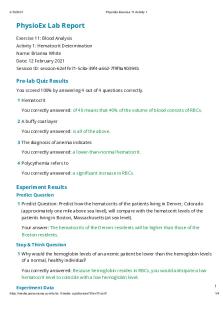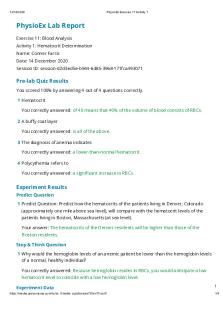Physio Ex Exercise 11 Activity 3 PDF

| Title | Physio Ex Exercise 11 Activity 3 |
|---|---|
| Author | Channon Lawrence |
| Course | Human Anatomy & Physiology Ii |
| Institution | Farmingdale State College |
| Pages | 3 |
| File Size | 60.8 KB |
| File Type | |
| Total Downloads | 34 |
| Total Views | 151 |
Summary
Download Physio Ex Exercise 11 Activity 3 PDF
Description
PhysioEx Lab Report Exercise 11: Blood Analysis Activity 3: Hemoglobin Determination Name: Channon Lawrence Date: 7 November 2020 Session ID: session-1d0058dd-2680-ccbc-2034-adba2dc5826e
Pre-lab Quiz Results You scored 100% by answering 3 out of 3 questions correctly. 1 A protein found in red blood cells, __________, is necessary for the transport of oxygen from the lungs to the cells of the body. You correctly answered: hemoglobin (Hb). 2 Anemia results when You correctly answered: There is inadequate hemoglobin in the red blood cells, and insufficient oxygen is carried in the blood. 3 How much hemoglobin does normal adult human blood contain? You correctly answered: 12–18 g/100 ml.
Experiment Results Predict Question 1 Predict Question: How will the hemoglobin levels for the female Olympic athlete (sample 5) compare with the hemoglobin levels for the healthy female (sample 2)? Your answer: The hemoglobin levels for the female Olympic athlete will be greater than those for the healthy female. Stop & Think Question 1 Why is the average hematocrit higher in males than in females? You correctly answered: Higher testosterone levels in males promotes more RBC production. Experiment Data Blood sample 1
gm Hb per 100 ml blood 16
Hematocrit (PCV)
Ratio of PCV to Hb
48
3:1
i
2
14
44
3.14:1
3
8
40
5:1
4
20
60
3:1
5
22
60
2.73:1
Sample 1: healthy male Sample 2: healthy female Sample 3: female with iron-deficiency amenia Sample 4: male with polycythemia Sample 5: female Olympic athlete
Post-lab Quiz Results You scored 100% by answering 3 out of 3 questions correctly. 1 To determine the amount of hemoglobin in a blood sample You correctly answered: All of these answers are correct. 2 Which of the following diseases is known to increase hemoglobin levels in an individual? You correctly answered: polycythemia. 3 Which of the following is known to decrease hemoglobin levels in an individual? You correctly answered: cirrhosis of the liver.
Review Sheet Results 1 Is the male with polycythemia (sample 4) deficient in hemoglobin? Why? Your answer: No, cause polycythemia means increasing the number of erythrocytes. 2 How did the hemoglobin levels for the female Olympic athlete (sample 5) compare with the hemoglobin levels for the healthy female (sample 2)? Is either person deficient in hemoglobin? How well did the results compare with your prediction? Your answer: The hemoglobin level of the female Olympic athlete is higher than that of the healthy female, as predicted. Nobody is deficient in hemoglobin. i
3 List conditions in which hemoglobin levels would be expected to decrease. Provide reasons for the change when possible. Your answer: - Anemia - Cirrhosis - Hyperthyroidism - Renal disease - Hemorrhage. 4 List conditions in which hemoglobin levels would be expected to increase. Provide reasons for the change when possible. Your answer: - Polycythemia - Heart failure - Obstructive pulmonary disease. 5 Describe the ratio of hematocrit to hemoglobin for the healthy male (sample 1) and female (sample 2). (A normal ratio of hematocrit to grams of hemoglobin is approximately 3:1.) Discuss any differences between the two individuals. Your answer: The ratio of the male is 3:1. The ratio of the female is 3.14:1. A difference between the two individuals might stem from hormones and body mass. Hence, this might be the reason why they have different ratios. 6 Describe the ratio of hematocrit to hemoglobin for the female with iron-deficiency anemia (sample 3) and the female Olympic athlete (sample 5). (A normal ratio of hematocrit to grams of hemoglobin is approximately 3:1.) Discuss any differences between the two individuals. Your answer: The ratio of a female with iron-deficiency is 5:1. The ratio of a female athlete is 2.73:1. Therefore, a female with iron-deficiency has less hemoglobin. However, an athlete has more erythrocytes.
i...
Similar Free PDFs

Physio Ex Exercise 11 Activity 3
- 3 Pages

Physio Ex Exercise 11 Activity 3
- 3 Pages

Physio Ex Exercise 11 Activity 1
- 4 Pages

Physio Ex Exercise 11 Activity 1
- 4 Pages

Physio Ex Exercise 11 Activity 4
- 4 Pages

Physio Ex Exercise 11 Activity 1
- 4 Pages

Physio Ex Exercise 11 Activity 2
- 5 Pages

Physio Ex Exercise 11 Activity 4
- 4 Pages

Physio Ex Exercise 11 Activity 2
- 3 Pages

Physio Ex Exercise 11 Activity 1
- 4 Pages

Physio Ex Exercise 11 Activity 5
- 3 Pages

Physio Ex Exercise 11 Activity 4
- 6 Pages

Physio Ex Exercise 3 Activity 3
- 5 Pages

Physio Ex Exercise 11 Activity 2
- 3 Pages

Physio Ex Exercise 11 Activity 2
- 3 Pages

Physio Ex Exercise 11 Activity 1
- 4 Pages
Popular Institutions
- Tinajero National High School - Annex
- Politeknik Caltex Riau
- Yokohama City University
- SGT University
- University of Al-Qadisiyah
- Divine Word College of Vigan
- Techniek College Rotterdam
- Universidade de Santiago
- Universiti Teknologi MARA Cawangan Johor Kampus Pasir Gudang
- Poltekkes Kemenkes Yogyakarta
- Baguio City National High School
- Colegio san marcos
- preparatoria uno
- Centro de Bachillerato Tecnológico Industrial y de Servicios No. 107
- Dalian Maritime University
- Quang Trung Secondary School
- Colegio Tecnológico en Informática
- Corporación Regional de Educación Superior
- Grupo CEDVA
- Dar Al Uloom University
- Centro de Estudios Preuniversitarios de la Universidad Nacional de Ingeniería
- 上智大学
- Aakash International School, Nuna Majara
- San Felipe Neri Catholic School
- Kang Chiao International School - New Taipei City
- Misamis Occidental National High School
- Institución Educativa Escuela Normal Juan Ladrilleros
- Kolehiyo ng Pantukan
- Batanes State College
- Instituto Continental
- Sekolah Menengah Kejuruan Kesehatan Kaltara (Tarakan)
- Colegio de La Inmaculada Concepcion - Cebu